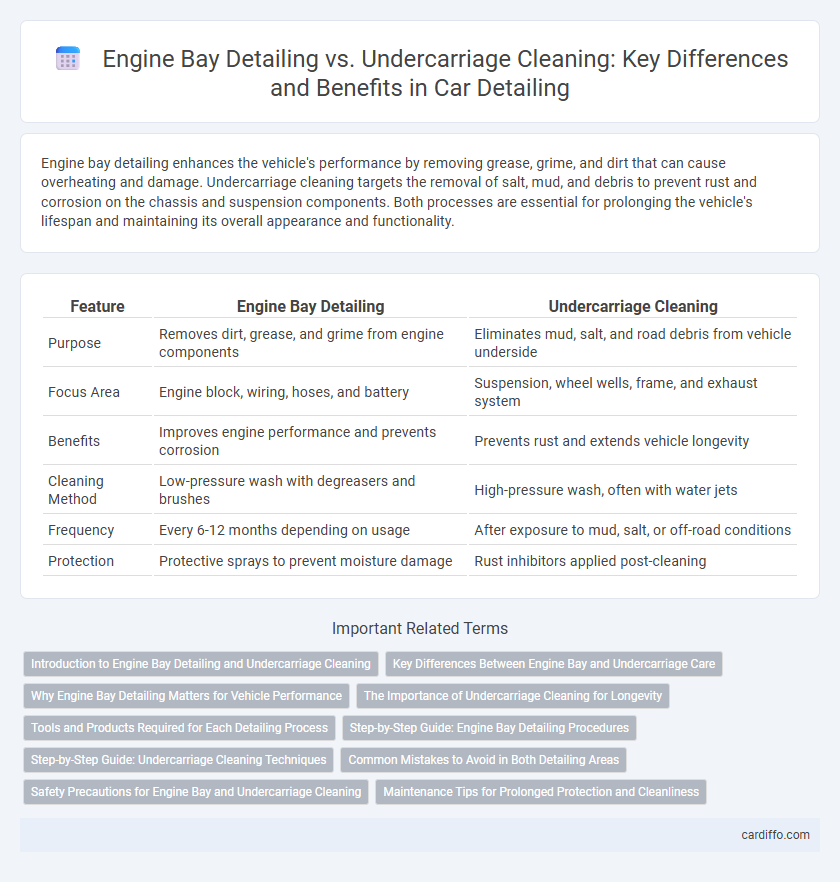Engine bay detailing enhances the vehicle's performance by removing grease, grime, and dirt that can cause overheating and damage. Undercarriage cleaning targets the removal of salt, mud, and debris to prevent rust and corrosion on the chassis and suspension components. Both processes are essential for prolonging the vehicle's lifespan and maintaining its overall appearance and functionality.
Table of Comparison
| Feature | Engine Bay Detailing | Undercarriage Cleaning |
|---|---|---|
| Purpose | Removes dirt, grease, and grime from engine components | Eliminates mud, salt, and road debris from vehicle underside |
| Focus Area | Engine block, wiring, hoses, and battery | Suspension, wheel wells, frame, and exhaust system |
| Benefits | Improves engine performance and prevents corrosion | Prevents rust and extends vehicle longevity |
| Cleaning Method | Low-pressure wash with degreasers and brushes | High-pressure wash, often with water jets |
| Frequency | Every 6-12 months depending on usage | After exposure to mud, salt, or off-road conditions |
| Protection | Protective sprays to prevent moisture damage | Rust inhibitors applied post-cleaning |
Introduction to Engine Bay Detailing and Undercarriage Cleaning
Engine bay detailing involves meticulous cleaning and restoration of the engine compartment, targeting grease, grime, and debris buildup to enhance performance and aesthetics. Undercarriage cleaning focuses on removing dirt, salt, and contaminants from the vehicle's underside, preventing corrosion and extending the lifespan of suspension and brake components. Both processes are essential for comprehensive vehicle maintenance, improving overall functionality and resale value.
Key Differences Between Engine Bay and Undercarriage Care
Engine bay detailing involves meticulous cleaning and degreasing of engine components, electrical parts, and metal surfaces, ensuring optimal performance and preventing corrosion. Undercarriage cleaning targets the removal of dirt, mud, salt, and road grime from the vehicle's underbody, suspension parts, and frame to prevent rust and maintain structural integrity. Key differences lie in the specific focus areas and cleaning techniques, with engine bay care requiring delicate handling of sensitive engine parts, while undercarriage cleaning emphasizes heavy-duty pressure washing to remove tough contaminants.
Why Engine Bay Detailing Matters for Vehicle Performance
Engine bay detailing removes built-up grease, dirt, and debris that can cause overheating and reduce engine efficiency, directly improving vehicle performance. Cleaning the engine bay prevents corrosion on critical components and helps identify potential issues such as leaks or worn parts early. Unlike undercarriage cleaning, which targets suspension and drivetrain components, engine bay detailing focuses on maintaining optimal engine health and reliability.
The Importance of Undercarriage Cleaning for Longevity
Undercarriage cleaning removes accumulated dirt, salt, and debris that cause rust and corrosion, extending the vehicle's lifespan. Unlike engine bay detailing, which focuses on enhancing engine aesthetics and performance, undercarriage cleaning protects critical components from damage and wear. Regular maintenance of the undercarriage ensures improved safety, durability, and overall vehicle value.
Tools and Products Required for Each Detailing Process
Engine bay detailing requires specialized degreasers, brushes, and plastic-safe protectants to remove grime while protecting electrical components. Undercarriage cleaning involves high-pressure washers, rust inhibitors, and heavy-duty degreasers designed to tackle road salt, mud, and debris accumulated beneath the vehicle. Both processes benefit from microfiber towels and foam applicators to ensure thorough cleaning and finishing without causing damage.
Step-by-Step Guide: Engine Bay Detailing Procedures
Engine bay detailing begins with disconnecting the battery and covering sensitive components like the alternator and air intake to prevent water damage. Use a degreaser spray to break down oil and grime, followed by gentle scrubbing with a soft brush to reach tight areas. Rinse carefully with low-pressure water, dry thoroughly with microfiber towels, and apply a protective dressing to hoses and plastic parts to enhance appearance and longevity.
Step-by-Step Guide: Undercarriage Cleaning Techniques
Undercarriage cleaning begins by lifting the vehicle using ramps or a hydraulic lift to access hard-to-reach areas beneath the chassis. Pressure washing with high PSI and a specialized nozzle removes dirt, grime, and road salt effectively, targeting suspension components, wheel wells, and exhaust systems. Finishing with a rust inhibitor spray prevents corrosion, ensuring long-term protection while enhancing the vehicle's structural integrity and appearance.
Common Mistakes to Avoid in Both Detailing Areas
Common mistakes in engine bay detailing include using excessive water pressure, which can damage electrical components, and neglecting to degrease tough oil stains properly. Undercarriage cleaning errors often involve missing hidden rust spots and failing to remove accumulated road salt, leading to accelerated corrosion. Proper product selection and thorough drying are essential to avoid damage and maintain vehicle longevity in both engine bay and undercarriage maintenance.
Safety Precautions for Engine Bay and Undercarriage Cleaning
Engine bay detailing requires disconnecting the battery and covering sensitive electrical components to prevent water damage and short circuits, ensuring safety during the cleaning process. Undercarriage cleaning demands the use of a pressure washer with appropriate nozzles and protective gear to avoid injury from debris and high-pressure water. Both tasks should be performed in a well-ventilated area with the vehicle securely lifted or on a flat surface to prevent accidents.
Maintenance Tips for Prolonged Protection and Cleanliness
Regular engine bay detailing removes dirt, grease, and debris that can cause corrosion and reduce engine efficiency, while undercarriage cleaning targets mud, salt, and grime buildup critical for preventing rust and structural damage. Using high-quality degreasers and pressure washers designed for each area ensures thorough cleaning without damaging sensitive components. Applying protective coatings such as silicone-based sprays in the engine bay and rust inhibitors on the undercarriage prolongs cleanliness and enhances resistance to environmental factors.
Engine Bay Detailing vs Undercarriage Cleaning Infographic

 cardiffo.com
cardiffo.com